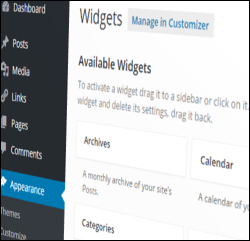 As we have discussed in this post, there are many benefits in using WordPress to build, manage and grow a website or blog. One of these is that you can easily add content, expand your website’s functionality, or reconfigure your site’s layout without requiring coding skills.
As we have discussed in this post, there are many benefits in using WordPress to build, manage and grow a website or blog. One of these is that you can easily add content, expand your website’s functionality, or reconfigure your site’s layout without requiring coding skills.
WordPress gives you the ability to quickly and easily add, delete, and reconfigure various types of content on your blog’s sidebar menu (or header and footer sections too, depending on your theme) using widgets.
Once you know how to use widgets, you can easily add things to your site’s sidebar area (plus headers and footers and other areas, depending on the theme you have installed) like:
- site pages
- content categories
- archives
- menus
- links to resources
- posts that you want to promote
- excerpts of recent comments added to posts
- clickable text ads
- testimonials
- surveys & polls
- content from RSS feeds
- shopping cart forms
- image galleries
- Facebook feeds
- add widgets from external sites (e.g. Facebook)
- administrative forms (e.g. login, register, etc.)

(Widgets make managing and using WordPress easy)
To learn more about what widgets are, how widgets work and why widgets make managing your site easier, see this article:
In this step-by-step tutorial series we teach you how to use and configure various frequently-used WordPress widgets.
How To Use Widgets
What You Need To Know First
Before configuring and using widgets, let’s make sure that you understand some of the basics of using widgets:
Most WordPress Themes Support Widget-Ready Layouts
Many WordPress themes support widgets and provide widgetized areas in the theme’s layout where widgets can be added to, such as the sidebar, header area, and the footer area. Depending on the theme, widgets can also be used inside the content area …
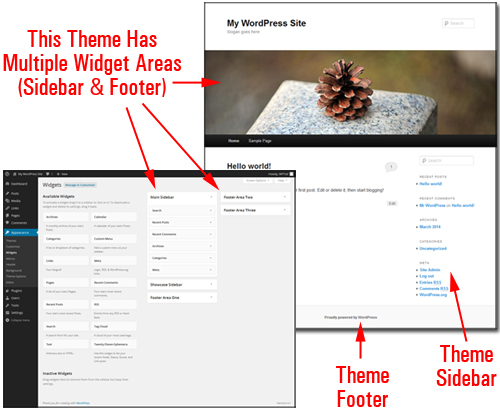
(Many themes provide a number of widget-ready sections)
These widgetized sections correspond to a feature inside the Widget administration panel called “Widget Areas” …

(Widget Areas)
Your Widgets Screen
The Widgets panel displays all the widgets that can be used on your site.
The right-hand section of the window displays your “active” widgets …

(Activate or deactivate widgets with drag and drop ease)
Available widgets can be activated or deactivated using drag & drop.
Widgets dragged from the Available Widgets section to widget areas like the sidebar, footer, etc. immediately become active and available for use on your site.
In addition, the Widgets area includes an Inactive Widgets section that lets you remove any widgets that you no longer want to use on your site. Inactive widgets retain their pre-configured settings.
Reorganize Widgets With Drag-And-Drop
You can easily add, activate, deactivate, rearrange and remove things using widgets just by dragging and dropping items in the Widgets section …

(Rearrange widgets on your WordPress site using drag & drop)
You can also easily reorder your theme’s layout using drag-and-drop.
For example, in the image below, the widgets have already been configured to display things like:
- An opt-in form,
- A contact support banner, and
- ’Click to call’ feature from a widgetized plugin (i.e. a plugin that adds an accompanying widget to your site) …
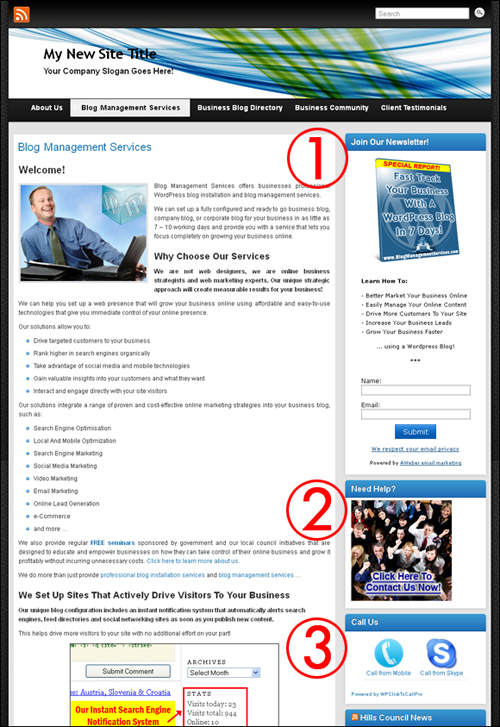
(Widgets control how certain features on your site appear)
If you look inside the example site’s Widget area, you will see that these features display on the site’s sidebar area in exactly the same order as their corresponding widgets have been arranged in the active widget area …

Let’s now change the order the above widgets in the Active Widget Area using drag & drop …
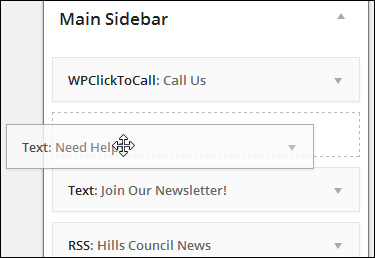
(Drag & drop to rearrange widgets in the widget area)
The widget features have now been reordered in the sidebar navigation menu …

This instantly changes the order of items in the sidebar.
Rearranging sidebar layout with widgets can improve user experience.
Note in the screenshot below that the ‘click to call’ function (3) is now the first item on the sidebar section, and the support section (2) is now found above the newsletter opt-in form (1) …
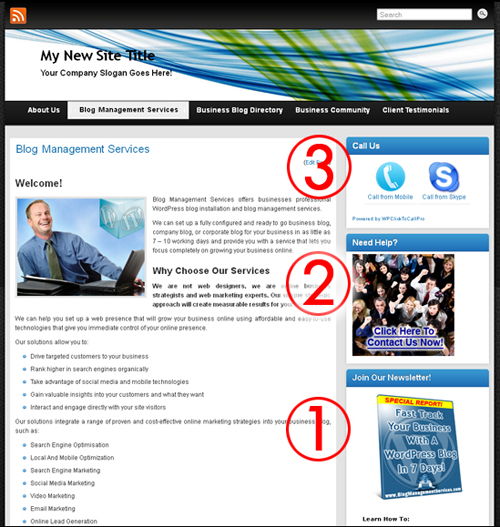
(Rearranging sidebar elements with widgets can help to improve your site’s visitor experience)
Deleting Widgets From Your WordPress Blog Sidebar Area
Removing widgets from your WordPress sidebar is very easy.
For example, let’s remove the Search widget from your sidebar …
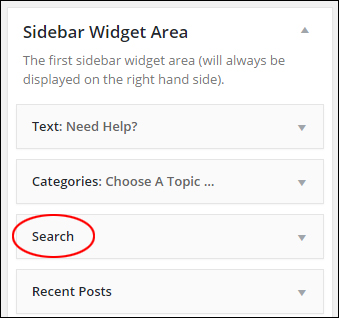
(Search widget)
To remove a widget from an active Widget area, you can either expand the widget settings and click the Delete link …

(Delete WordPress widgets)
Or just drag the widget out of the Active Widgets area and into the Inactive Widgets section …

(How to remove your WP widget)
Repeat this process for all widgets you want removed from your sidebar. You can always reinstate a widget by dragging it back into the active widgets area.
Widget Settings
Many widgets can be further customized. This includes making certain types of information hidden to your site visitors but visible to registered users, displaying additional forms, fields, or data, specifying sizes of sidebar images, videos, etc.
Click on the little triangle in the corner of a widget to display the widget’s settings …
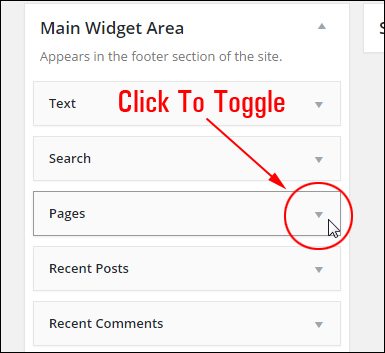
(Toggling expands/collapse widget settings)
When the widget expands, you can change and save your settings, delete your widget from the “Active Widgets” section, close the widget, or click on the triangle to collapse the widget …

(Widget settings)
![]()
Some widgets may require or offer no customization, or they may only allow you to add something like an optional title …

(Some widgets provide users with little to no customizable options)
Customize Widgets Section
Depending upon the theme you use, you’re also able to preview any changes live without making actual changes to your site. This way, you can be sure that you like your customizations before making any permanent changes to your website.
The ability to manage widgets inside your dashboard is a valuable feature of WordPress. You can work in preview mode inside the WordPress Theme Customizer screen (Appearance > Customize) and see how your widget content will appear before publishing it (and avoid making mistakes), or configure widgets on the fly using the Widget editor area.
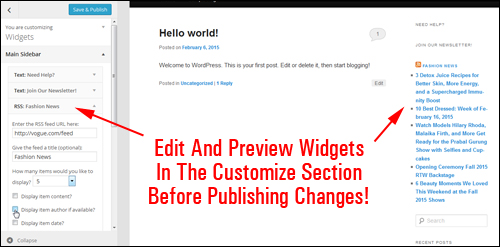
(preview widget changes live in the Customize feature)
When viewing your site on the front-end just calick the Customize link in the toolbar …

(Customize link in the toolbar)
This will bring you to the Customizer feature in the back-end.
You can do several modifications and adjustments in preview mode (like inserting, deleting and moving widgets around), and this will all be done in real time. If you are happy with the results, click the “Save and Publish” button and your changes will then be instantly applied and reflected on your site.
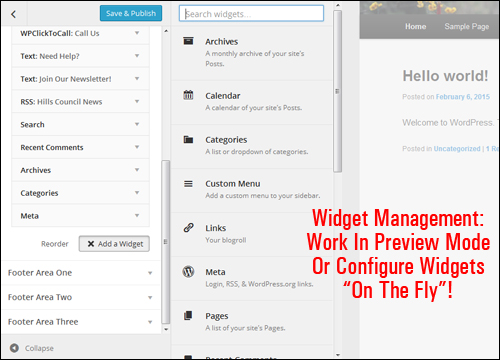
(Widget management – configure widgets on the fly!)
After saving changes, the new configuration will automatically be displayed on your site.
![]()
Since WordPress Themes can display elements differently on your site, we recommend installing the theme first before configuring widgets.
Also, remember to use the Customizer feature to preview your changes. This saves you from having to keep two browsers open while you complete this tutorial.
Now that you know the basics of using widgets, let’s begin configuring various commonly-used WordPress sidebar widgets.
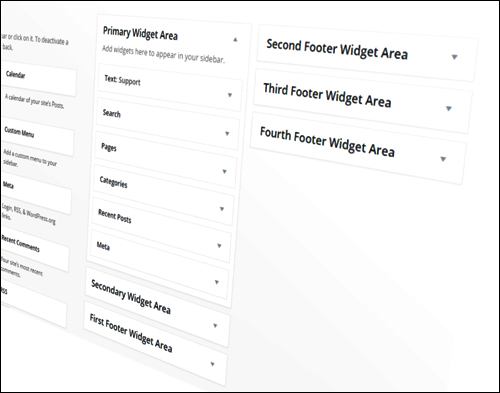
***
This is the end of section 1 of this series of tutorials on using WordPress widgets.
To view the rest of this tutorial series, click this link:
***
"I am beyond impressed with what you have put together. I can tell that you put a ton of hard work into building what you have. You have the absolute best content on WordPress I have ever seen!" - Robert T. Jillie
***